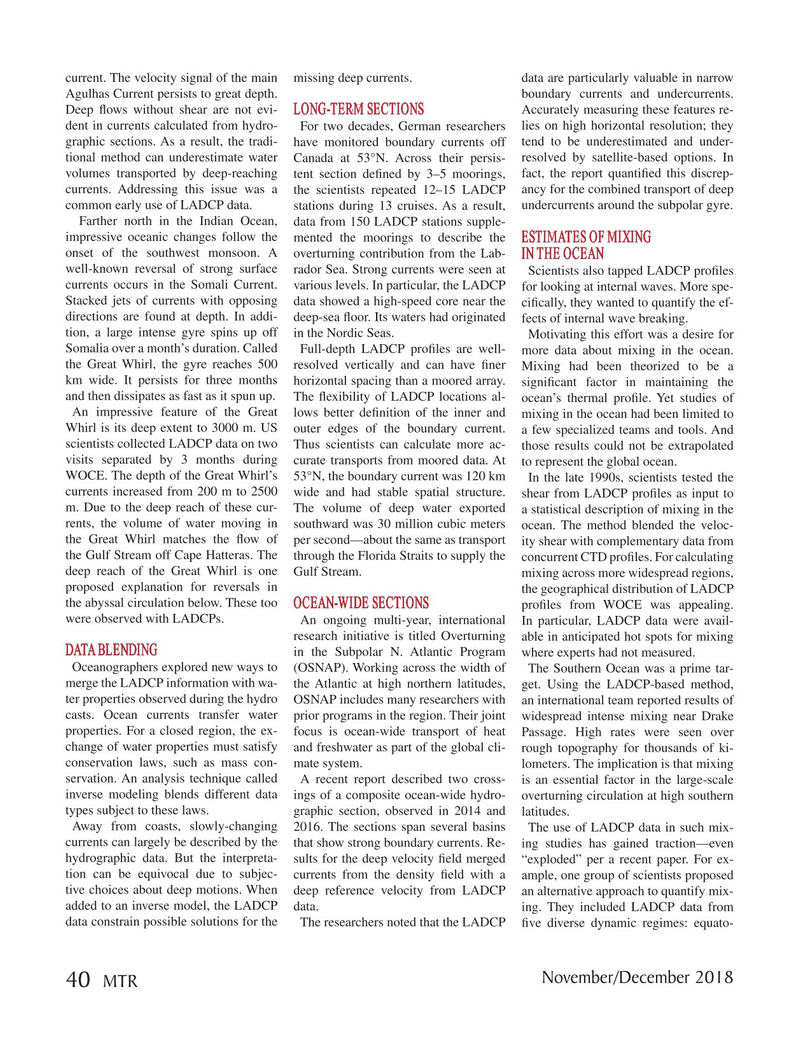
Page 40: of Marine Technology Magazine (November 2018)
Acoustic Doppler Sonar Technologies ADCPs and DVLs
Read this page in Pdf, Flash or Html5 edition of November 2018 Marine Technology Magazine
current. The velocity signal of the main missing deep currents. data are particularly valuable in narrow
Agulhas Current persists to great depth. boundary currents and undercurrents.
Deep ? ows without shear are not evi- Accurately measuring these features re-
LONG-TERM SECTIONS dent in currents calculated from hydro- For two decades, German researchers lies on high horizontal resolution; they graphic sections. As a result, the tradi- have monitored boundary currents off tend to be underestimated and under- tional method can underestimate water Canada at 53°N. Across their persis- resolved by satellite-based options. In volumes transported by deep-reaching tent section de? ned by 3–5 moorings, fact, the report quanti? ed this discrep- currents. Addressing this issue was a the scientists repeated 12–15 LADCP ancy for the combined transport of deep common early use of LADCP data. stations during 13 cruises. As a result, undercurrents around the subpolar gyre.
Farther north in the Indian Ocean, data from 150 LADCP stations supple- impressive oceanic changes follow the mented the moorings to describe the
ESTIMATES OF MIXING onset of the southwest monsoon. A overturning contribution from the Lab-
IN THE OCEAN well-known reversal of strong surface rador Sea. Strong currents were seen at Scientists also tapped LADCP pro? les currents occurs in the Somali Current. various levels. In particular, the LADCP for looking at internal waves. More spe-
Stacked jets of currents with opposing data showed a high-speed core near the ci? cally, they wanted to quantify the ef- directions are found at depth. In addi- deep-sea ? oor. Its waters had originated fects of internal wave breaking. tion, a large intense gyre spins up off in the Nordic Seas. Motivating this effort was a desire for
Somalia over a month’s duration. Called Full-depth LADCP pro? les are well- more data about mixing in the ocean. the Great Whirl, the gyre reaches 500 resolved vertically and can have ? ner Mixing had been theorized to be a km wide. It persists for three months horizontal spacing than a moored array. signi? cant factor in maintaining the and then dissipates as fast as it spun up. The ? exibility of LADCP locations al- ocean’s thermal pro? le. Yet studies of
An impressive feature of the Great lows better de? nition of the inner and mixing in the ocean had been limited to
Whirl is its deep extent to 3000 m. US outer edges of the boundary current. a few specialized teams and tools. And scientists collected LADCP data on two Thus scientists can calculate more ac- those results could not be extrapolated visits separated by 3 months during curate transports from moored data. At to represent the global ocean.
WOCE. The depth of the Great Whirl’s 53°N, the boundary current was 120 km In the late 1990s, scientists tested the currents increased from 200 m to 2500 wide and had stable spatial structure. shear from LADCP pro? les as input to m. Due to the deep reach of these cur-
The volume of deep water exported a statistical description of mixing in the rents, the volume of water moving in southward was 30 million cubic meters ocean. The method blended the veloc- the Great Whirl matches the ? ow of per second—about the same as transport ity shear with complementary data from the Gulf Stream off Cape Hatteras. The through the Florida Straits to supply the concurrent CTD pro? les. For calculating deep reach of the Great Whirl is one Gulf Stream. mixing across more widespread regions, proposed explanation for reversals in the geographical distribution of LADCP the abyssal circulation below. These too
OCEAN-WIDE SECTIONS pro? les from WOCE was appealing. were observed with LADCPs.
An ongoing multi-year, international In particular, LADCP data were avail- research initiative is titled Overturning able in anticipated hot spots for mixing
DATA BLENDING in the Subpolar N. Atlantic Program where experts had not measured.
Oceanographers explored new ways to (OSNAP). Working across the width of The Southern Ocean was a prime tar- merge the LADCP information with wa- the Atlantic at high northern latitudes, get. Using the LADCP-based method, ter properties observed during the hydro OSNAP includes many researchers with an international team reported results of casts. Ocean currents transfer water prior programs in the region. Their joint widespread intense mixing near Drake properties. For a closed region, the ex- focus is ocean-wide transport of heat Passage. High rates were seen over change of water properties must satisfy and freshwater as part of the global cli- rough topography for thousands of ki- conservation laws, such as mass con- mate system. lometers. The implication is that mixing servation. An analysis technique called A recent report described two cross- is an essential factor in the large-scale inverse modeling blends different data ings of a composite ocean-wide hydro- overturning circulation at high southern types subject to these laws. graphic section, observed in 2014 and latitudes.
Away from coasts, slowly-changing 2016. The sections span several basins The use of LADCP data in such mix- currents can largely be described by the that show strong boundary currents. Re- ing studies has gained traction—even hydrographic data. But the interpreta- sults for the deep velocity ? eld merged “exploded” per a recent paper. For ex- tion can be equivocal due to subjec- currents from the density ? eld with a ample, one group of scientists proposed tive choices about deep motions. When deep reference velocity from LADCP an alternative approach to quantify mix- added to an inverse model, the LADCP data. ing. They included LADCP data from data constrain possible solutions for the The researchers noted that the LADCP ? ve diverse dynamic regimes: equato-
November/December 2018 40
MTR
MTR #9 (34-49).indd 40 MTR #9 (34-49).indd 40 11/27/2018 2:05:41 PM11/27/2018 2:05:41 PM

 39
39

 41
41
